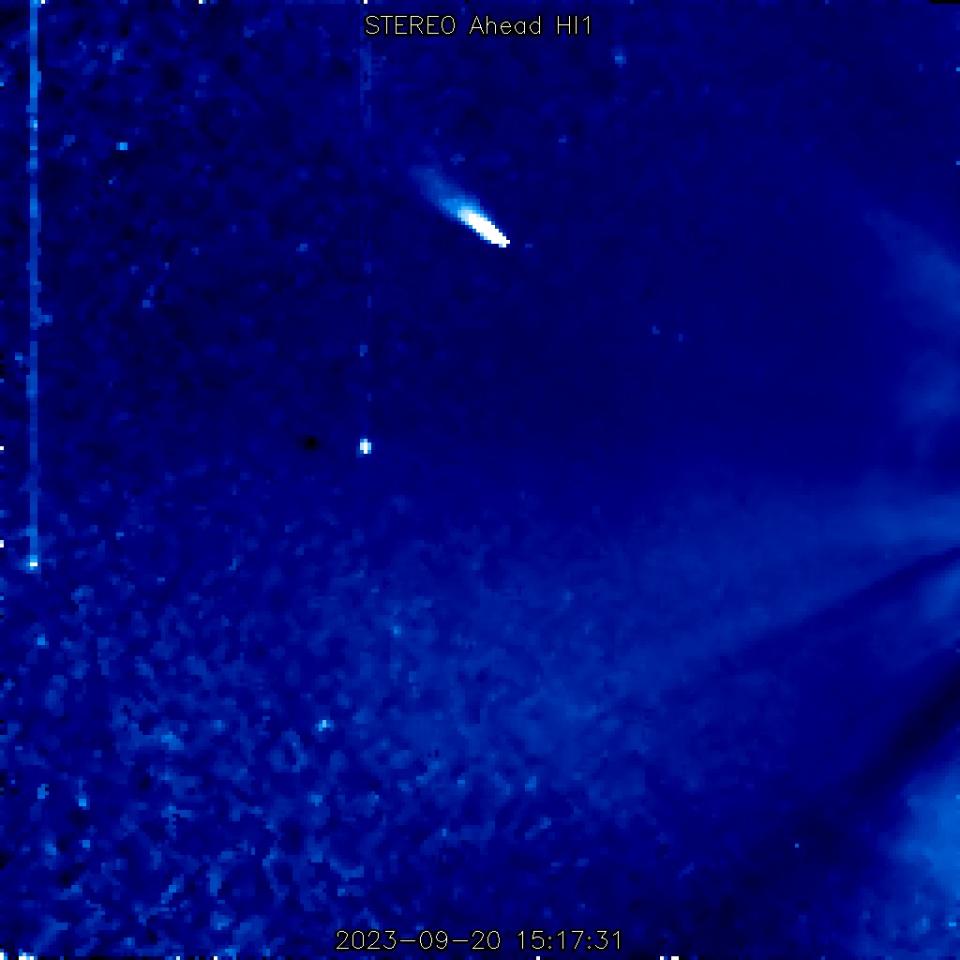Comet Nishimura photobombs NASA spacecraft after its close encounter with the sun (photos)

The recently discovered Comet Nishimura has surprised scientists by photobombing a NASA spacecraft as it took images of the sun.
Comet Nishimura, also known as C/2023 P1, which appears to have recently survived a close encounter with the sun, was seen by one of two Solar TErrestrial RElations Observatory (STEREO) spacecraft — STEREO-A — as it took images of the sun's outer atmosphere, the corona, on Sept. 19.
The STEREO images show the comet moving away from the sun and seem to imply that the comet survived its brush with the star on Sept. 17, when it reached its closest point to the sun, or "perihelion," and passed within 20.5 million miles (33 million km) of it.
"So yes, the object you see in those STEREO-A/HI1 observations is indeed comet Nishimura. At the time of writing, the most recent image shows it appears pretty healthy at-a-glance," Karl Battams, an astrophysicist with the U.S. Naval Research Laboratory, told Space.com by email.
Battams said that at the moment, from these preliminary images, Nishimura looks how scientists would expect an intact comet to look, but noted that he is wary of drawing any meaningful conclusions about how it is holding together after being heated by the sun.
"First, it's crucial to keep in mind that the images you're seeing right now are what we call our 'beacon' images," Battams continued. "These are low cadence, ultra-low resolution images, designed to just give a near-real-time snapshot of what the camera is seeing."

According to Battams, it will be late on Thursday (Sept. 21) before the team gets their first look at the comet in much better resolution, and even then, it might not fully reveal the fate of the comet.
"My mind goes back to comet Lovejoy in 2011, which appeared quite healthy as it flew right through the solar corona, only to then disintegrate a couple of weeks later," he added. "The same, ultimately destructive, processes could certainly be happening here, and we simply wouldn't know it. Thus, the high-res data might clue us in a bit, but not even that gives us any fine details on what's happening behind the glare of the bright tail and coma."
With a few days of science data under their belts, the team will still be able to look at the brightness of Nishimura to see if that yields any clues or surprises. "That only tells part of the story," Battams added. "Ultimately, we just have to wait this out and see what happens, but of course, I very much hope it remains a happy and healthy comet!"
Throughout the images captured by STEREO, it is clear to see Nishimura is moving downwards in relation to the spacecraft as it moves away from the sun. This trajectory will continue until it moves out of the field of view of the NASA observatory in early October, according to Battams.

The comet is also moving away from the spacecraft, so it will likely grow smaller and fainter in the images delivered by STEREO over the coming days. As of Sept. 20, it was about 93 million miles (150 million kilometers) from STEREO-A and by Oct. 1, the comet and the NASA craft will be separated by a distance of 130 million miles (209 million km).
"Folks trying to interpret the comet's health from this data will need to appreciate the changing viewing geometry, as well as the fact that we'd naturally expect it to start fading as it recedes from the sun," Battams pointed out.
RELATED STORIES:
— Will newfound Comet Nishimura really be visible to the naked eye? Experts aren't so sure
— How to view and photograph comets
— Watch 1 month in the life of a green comet during its journey past Earth (video)
It is lucky that STEREO caught an image of the comet; it was missed by NASA's Solar and Heliospheric Observatory (SOHO) and its LASCO coronagraph, which studies the outer atmosphere of the sun.
"Sadly, this one managed to avoid the SOHO/LASCO field of view," Battams concluded. "We may have or may get, observations from some of our other spacecraft or instruments, but nothing that returns data in real-time like SOHO and STEREO."
After it escapes the view of STEREO in October, comet Nishimura will continue to make its way back to the outer edges of the solar system. The comet, discovered on Aug. 12 as it brightened while hurtling toward the sun, will next return to the inner solar system Earth and the sun in 2458 thanks to its estimated 435-year-long orbit.

